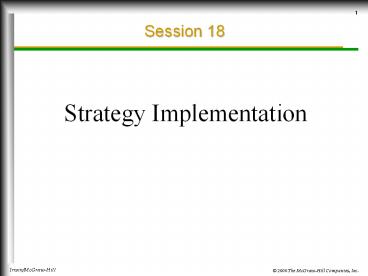Strategy Implementation - PowerPoint PPT Presentation
Title:
Strategy Implementation
Description:
Title: Strategic Management Subject: Pearce/Robinson Author: Linda Crane Last modified by: Keith Robbins Created Date: 6/25/1999 5:11:01 PM Document presentation format – PowerPoint PPT presentation
Number of Views:181
Avg rating:3.0/5.0
Title: Strategy Implementation
1
Session 18
- Strategy Implementation
2
Strategic Management Model
Company mission social responsibility
External Environment
Internal analysis
Possible?
Desired?
Strategic analysis choice
Long-term objectives
Generic grand strategies
Feedback
Feedback
Short-term objectives reward system
Functional tactics
Policies that empower action
Restructuring, reengineering refocusing the
organization
Legend
Major impact
Strategic control continuous improvement
Minor impact
3
Strategy Implementation
Identify short-term objectives
Initiate specific functional tactics
Communicate policies to empower people
Institutionalization - Design effective
support systems
4
What are Short-Term Objectives?
Provide specific guidance for what is to be done,
translating vision into action
5
Role of Short-Term Objectives in Implementing
Strategy
1. Operationalize long-term objectives
2. Raise issues and potential conflicts requiring
coordination to avoid dysfunctional consequences
3. Identify measurable outcomes of functional
activities to be used to make feedback,
correction, and evaluation more relevant
6
Examples Of Financial Objectives
- Growth in revenues
- Growth in earnings
- Wider profit margins
- Bigger cash flows
- Higher returns on invested capital
- Attractive and sustainable increases in market
value added (MVA) - A more diversified revenue base
7
Examples Of Strategic Market Objectives
- Bigger market share
- Quicker design-to-market times than rivals
- Higher product quality than rivals
- Lower costs relative to key competitors
- A stronger reputation with customers than rivals
- Superior customer service
- Wider geographic coverage than rivals
- Higher levels of customer satisfaction than
rivals
8
Potential Conflicting Objectives and Priorities
9
Relationship of Functional Tactics (Action Plans)
to Short-Term Objectives
Specificity - Identify functional activities to
be undertaken to build competitive advantage
Provide a clear time frame for completion
Identify who is responsible for each action in
the plan
10
Qualities of Effective Short-term Objectives
11
Creating Measurable Objectives
12
What are Functional Tactics?
13
Functional Tactics at General Cinema Corporation
14
Heres Where you Focus on the Two More
Significant of the Functional AreasOperationsMa
rketingAccounting and FinanceRD
TechnologyHuman Resources
15
Characteristics of Functional Tactics in
Operations
- Viewed as core function of an organization
- Involves converting inputs into value-enhanced
output - Focuses on decisions regarding
- Basic nature of firms POM system,
- Seeks optimum balance between investment input
and production/operations output - Location
- Facilities design
- Process planning on a short-term basis
16
Key Functional Tactics in POM
17
Characteristics of Functional Tactics in Marketing
- Lead to strategic success of the firm through the
profitable sale of products/services in target
markets - Clearly identify customer needs that
products/services aim to meet - Identify where, when, and by whom
products/services are to be sold - Define how firm will communicate with target
markets - Directly influence supply, demand, profitability,
consumer perception, and regulatory response
through pricing
18
Key Functional Tactics in Marketing
19
Characteristics of Functional Tactics in
Accounting and Finance
- Time frame of finance tactics varies because they
direct use of financial resources supporting the
business strategy, long-term goals, and annual
objectives - Long-term tactics guide decisions in
- Long-term capital investment
- Debt financing
- Dividend allocation
- Leveraging
- Short-term tactics guide decisions in
- Managing working capital and short-term assets
- Accounting-focused tactics have taken on
increased strategic significance in last decade
20
Key Functional Tactics in Finance and Accounting
21
Characteristics of Functional Tactics in RD
- Assumed a key strategic role in many firms due to
increasing rate of technological change - May be more critical instruments of business
strategy in some industries than in others
22
Key Functional Tactics in RD
23
Characteristics of Functional Tactics in HRM
- Assumed increasing strategic importance in the
1990s - Aid long-term success in
- Development of managerial talent and competent
employees - Creating systems to manage compensation or
regulatory concerns - Guiding effective utilization of human resources
to achieve both the - Firms short-term objectives
- Employees satisfaction and development
24
Key Functional Tactics in HRM
25
Role of Policies in Implementing Strategy
- Directives designed to guide thinking, decisions,
and actions of managers and employees in
implementing strategy - Increase managerial effectiveness by
- Standardizing many routine decisions
- Clarifying discretion managers and employees can
exercise in implementing functional tactics - Should be derived from functional tactics with
key purpose of aiding strategy execution
26
Why Policies Empower People
1. Establish indirect control over independent
action by clearly stating how things are to be
done now
2. Promote uniform handling of similar activities
3. Ensure quicker decisions by standardizing
answers to previously answered questions
4. Institutionalize basic aspects of
organization behavior
5. Reduce uncertainty in repetitive and
day-to-day decision making
6. Counteract resistance to or rejection of
chosen strategies by organization members
7. Offer predetermined answers to routine
problems
8. Afford managers a mechanism for avoiding
hasty and ill-conceived decisions in changing
operations
27
Advantages of Formal Written Policies
1. Require managers to think through policys
meaning, content, and intended use
2. Reduce misunderstanding
3. Make equitable and consistent treatment of
problems more likely
4. Ensure unalterable transmission of policies
5. Communicate authorization or sanction of
policies more clearly
6. Supply a convenient and authoritative reference
7. Systematically enhance indirect control and
organization-wide coordination of the key
purposes of policies
28
Types of Executive Bonus Compensation































